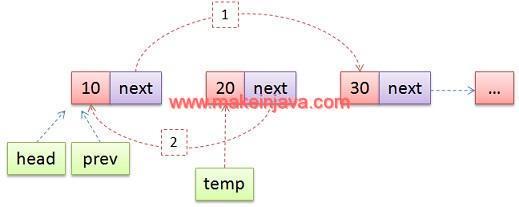- Given a single linked list, we would like to reverse a single linked list in pairs.
- We would like to reverse the nodes in pair (swap the references of alternate nodes).

Example – reverse singly linked list in pairs using java.
Reverse singly linked list in pairs (refer Fig 1)
- Swap Node 10 and 20 of single linked list.
- Node 20 will become head of single linked list.
- Node 10 become second node of single linked list.
- Swap Node 30 and 40
- Node become third node of a single linked list.
- Node 30 become fourth node of a single linked list
- Node 50 will be last node in linked list
- Singly linked list is reversed in pairs, as shown in a Fig 2.

- We can simply swap the data of nodes instead of swapping the references.
- Just for better understanding, we are swapping the references of node.
- It will give better insight of problem statement.
- So, we will use the swapping of references in our problem statement.
Algorithm: reverse single linked list in pairs in java (non recursive)
- Take prev pointer pointing at head of single linked list
- Store the reference of second node of single linked list
- As second node will become the new head of single linked list (Fig 2).
- temp reference pointing to next of head
- temp start pointing to Node 20
- Break the link between Node 10 and Node 20
- Set head.next to temp.next
- Node 10 start pointing to Node 30
- Set head.next to temp.next
- Set up the link between Node 20 to Node 10
- Set temp.next to head
- Node 20 start pointing to Node 10
- Node 20 will be new head of linked list
- Node 20 start pointing to Node 10
- Set temp.next to head
- Store the prev reference
- Which will be useful for next iteration
- We will follow the above procedure for rest of nodes
- Single linked list will be reversed in pairs. (Refer Fig 3)
Time complexity of algorithm is O (n).

Program – reverse single linked list in pairs using iterative algorithm in java.
1.) ReverseLinkedListInPair Class:
- We are passing the head of single linked list to ReverseLinkedListInPair class.
- We will reverse singly linked list in pairs.
package org.learn.Question;
import org.learn.List.Node;
public class ReverseLinkedListInPair {
public static Node reverseLinkedListInPair(Node head) {
Node prev = head;
Node newHead = head.next;
Node temp = head.next;
while (head != null && head.next != null) {
prev.next = head.next;
head.next = temp.next;
temp.next = head;
if (head.next != null) {
prev = head;
head = head.next;
temp = head.next;
}
}
return newHead;
}
public static void insert(Node head, int data) {
while (head.next != null)
head = head.next;
head.next = new Node(data);
}
public static void print(Node head) {
while (head != null) {
System.out.printf("%d ", head.data);
head = head.next;
}
System.out.println("");
}
}
2.) DemoLinkedListInPairs Class:
- We are creating the single linked list in main method.
- We are calling ReverseLinkedListInPair.reverseLinkedListInPair method, to reverse single linked list in pairs.
package org.learn.Client;
import org.learn.List.Node;
import org.learn.Question.ReverseLinkedListInPair;
public class DemoLinkedListInPairs {
public static void main(String[] args) {
int[] data = { 10, 20, 30, 40, 50 };
Node head = new Node(data[0]);
for (int count = 1; count < data.length; count++) {
ReverseLinkedListInPair.insert(head, data[count]);
}
System.out.printf("1. Single linked list is : ");
ReverseLinkedListInPair.print(head);
System.out.printf("2. Reverse single linked list in pairs : ");
head = ReverseLinkedListInPair.reverseLinkedListInPair(head);
ReverseLinkedListInPair.print(head);
}
}
3.) Node Class:
- Node class is representing the nodes of a single linked list
package org.learn.List;
public class Node {
public int data;
public Node next;
public Node(int num) {
this.data = num;
this.next = null;
}
}
Output – reverse singly linked List in pairs in java (iterative)
1. Single linked list is : 10 20 30 40 50 2. Reverse single linked list in pairs : 20 10 40 30 50
